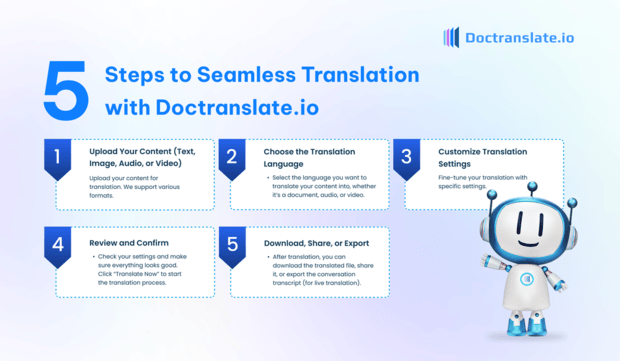Introduction
Translating software strings is a vital task for reaching a global user base. It ensures your application is accessible and user-friendly in different languages and cultures.
Breaking language barriers opens up new markets and opportunities. Accurate and efficient translation is key to success in an international landscape.
When dealing with software strings, precision is paramount. Context and consistency are essential to avoid errors or awkward phrasing in the user interface.
DocTranslate.io offers a powerful and straightforward solution for this challenge. It handles various file types commonly used for software strings.
This guide focuses on translating your Ukrainian software strings into English. We will walk through the simple steps using the robust features of DocTranslate.io.
Step-by-Step Guide: Translating Documents with Software Strings from Ukrainian to English with DocTranslate.io

Step 1: Upload Your Content
The first step is to get your software string file into DocTranslate.io. You will likely have these strings stored in a document or spreadsheet.
Navigate to the **Document Translate** section on the website. This feature is designed for handling files like yours.
You can easily upload your file by clicking the ‘Upload’ button. Alternatively, you can simply drag and drop the file into the designated area on the page.
DocTranslate.io supports several common formats for software strings. These include .xlsx, .docx, .pptx, and .pdf files. Choose the file containing your Ukrainian strings.
While the focus here is documents, DocTranslate.io handles other types:
- For text up to 5000 words: **Translate Text**
- For images (.PDF, JPG, JPEG, PNG): **Translate Image**
- For audio (.MP3, WAV): **Translate Audio**
- For video (.MP4, SRT) or YouTube links: **Translate Video**
Step 2: Choose the Translation Language
Once your document is uploaded, the next crucial step is selecting your desired languages. You need to identify the original language of your software strings file.
In this specific case, your source language is Ukrainian. Select ‘Ukrainian’ from the list of available input languages provided by the platform.
Then, choose the language you want your content translated into. For translating software strings for an English-speaking audience, select ‘English’ as your target language.
DocTranslate.io supports a vast array of languages. This makes it easy to connect with a global audience, no matter your starting or target language.
Step 3: Customize Your Translation Settings
Accuracy in software string translation is vital. **DocTranslate.io** offers several customization options to ensure the translation meets your specific requirements.
For document translation, you can tailor the output. Consider using features like ‘Tone’ and ‘Domain’ to guide the translation style and terminology, ensuring it fits the software context.
The ‘Bilingual translation’ option is particularly useful for reviewing. It provides a side-by-side comparison of the source (Ukrainian) and translated (English) text within the same document.
If your software strings file includes images or specific technical terms, leverage options like ‘Translate images within text’ or ‘My Dictionary’. ‘My Dictionary’ lets you add custom terms for consistent translation. Learn more about Document features.
Remember, customization helps maintain consistency. This is especially important across thousands of software strings in an application interface.
While focusing on documents, other features offer customization too:
- Text: Font, size, color, and bilingual options. **Customize Text Translation**
- Image: Tone, domain, My Dictionary. **Customize Image Translation**
- Video: Tone, domain, bilingual, My Dictionary for text within video. **Customize Video Translation**
Step 4: Review and Confirm
Before you initiate the translation process, take a moment to review your settings. Double-check that you have selected the correct source (Ukrainian) and target (English) languages.
Also, confirm that any customization options you selected, like Domain or Bilingual output, are correctly configured according to your needs for translating software strings.
Once you are satisfied with all the settings, you are ready to proceed. The system is prepared to process your document.
Click the ‘Translate Now’ button to start the translation. DocTranslate.io will then begin processing your Ukrainian file into English.
Step 5: Download, Share, or Export
After the translation process is complete, DocTranslate.io will notify you. The translated English version of your document will be ready.
You can then easily download the translated file directly to your computer. This file will contain all your software strings accurately translated into English, following your chosen settings.
If you chose the bilingual option, the downloaded file will include both the original Ukrainian strings and their English translations, which is great for review.
You can now use this translated document. Integrate the English strings into your software to provide a localized experience for English-speaking users.
Conclusion
Translating your valuable software strings from Ukrainian to English is a crucial step for global reach. Ensuring accuracy and consistency across your application is paramount.
With DocTranslate.io, this complex task becomes manageable and efficient. The platform simplifies the process from uploading your document to downloading the final translation.
By following these easy steps, you can leverage the powerful features of DocTranslate.io. This ensures your software strings are translated accurately and efficiently, tailored to your specific requirements.
Ready to expand your software’s reach? Start translating your documents containing software strings today. Experience the benefits of connecting with an English-speaking audience.
Visit **DocTranslate.io** to get started and transform your translation workflow. You can even get 5 free credits by signing up! Sign up here.


Leave a Reply